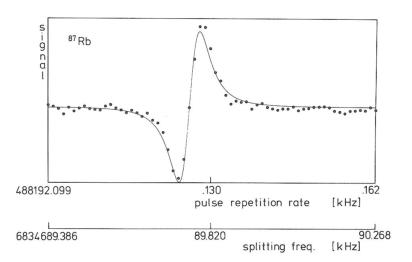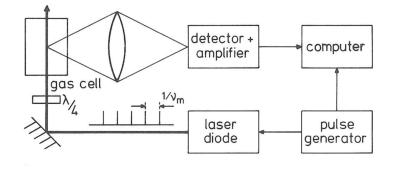




c) Coherence Spectroscopy with Pulse Trains
Actively mode-locked lasers or pulsed semiconductor lasers, which are controlled by a frequency synthesizer, are generating ultrashort light pulses with well defined and highly stable pulse repetition rates in the MHz up to the GHz range. Each individual pulse can create a coherent superposition of nearly degenerate atomic states or sub-states, when the laser wavelength is tuned to an optical transition of the atoms or molecules and the pulse is short enough to excite the involved atomic states coherently, i.e., the Fourier transform spectrum of the pulse covers the respective sub-level splitting. Under such conditions a new pulse already interacts with the sample, while a substantial coherent contribution created by previous pulses is still existing. If the individual pulses are sufficiently weak and are not erasing the already existing coherences, they can be assumed to generate a small but constant contribution to the atomic coherences, each oscillating with the splitting frequencies of the involved sub-states and damped at a rate gamma. Constructive interference of these different contributions give rise to very sharp resonances in the resulting macroscopic coherence amplitude, whenever the excitation rate or a higher harmo- nic coincides with the atomic splitting frequency. This coherence phenomenon is quite similar to multiple beam interference of optical rays with damped amplitudes as known from Fabry-Perot interferometers.Polarization Selective Detection
Such an enhanced coherent superposi- tion can sensitively be measured by a si- milar experimental set-up as used for quantum beats in forward scattering, but now tuning the laser repetition rate and monitoring the average intensity of probe pulses behind a crossed polarizer. There- fore, this periodic pulse excitation meth- od is directly measuring level splittings in the frequency domain. Since ground state coherent transients are characterized by extremely low relaxation rates, very sharp resonances of ajacent level splittings can be expected. But under usual experimental con- ditions the observed resonance width is limited by transient time-of-flight broadening of the atoms through the probe beam. From optical pumping experiments in alkaline atoms it is well known that an additional buffer gas in the vapor cell considerably reduces diffusion of the atoms out of the interaction region without sufficiently destroying the ground state coherence. Under such conditions periodic pulse excitation allows ultrahigh resolution spectroscopy. So, the 133 Cs hyperfine ground state splitting of 9.2 GHz, e.g., can be measured with a resonance width of only 30 Hz, which corresponds to a Q-factor (9.2 GHz to 30 Hz) of 3*10 8 . In this case the laser operates with a pulse repetition rate of 84 MHz and scans through the atomic resonance with the 120th harmonic of the pulse rate, which is only tuned over 0.25 Hz.Fluorescence Detection
In an appropriate basis of atomic eigenstates an atomic coherence can be described as an oscill- ating population difference between adjacent sub-states. This oscillation occurs with the respec- tive splitting frequency of the sub-levels. Pulses with the right polarization only act on special sub-states and can change the population density of these states with a definite phase. When the pulse repetition rate or some higher harmonic coincides with the oscillation frequency between two sub-states, the pulse train burns a ‘hole’ into the population density with the consequence that succeeding pulses interact with the atoms at times when the population is low. Therefore, less atoms are excited on the optical transition and reduced fluorescence radiation is observed. Such signal results from coherent trapping of atoms in the ground state and can be described as a non-absorbing resonance. With Rb and additional buffer gas in the vapor cell the atoms are excited by a semiconductor laser on the D 2 resonance line at 780 nm. The diode laser is directly triggered by a step reco- very diode (comb generator) and produces pulses as short as 40 ps at a repetition rate of 488 MHz. To ensure single-mode operation, the laser is additionally coupled to an external re- sonator. The hyperfine ground state splitting of Rb-87 with 6.835 GHz is measured with the 14th harmonic of the pulse rate by monitoring the fluorescence radiation on the D 2 line as a function of the pulse repetition rate. To discriminate laser straylight from the fluorescence light, the atoms are subjected to a slightly modulated magnetic field, which also slightly and periodically shifts the atomic resonance by some tenth Hz. This allows to use lock-in detection technique, which suppresses a larger back- ground and in this case measures the deriva- tive of the resonance signal as a dispersion- like curve. In this way the ground state splitting can be determined with an uncertainty of less than 1 Hz, and with a stabilization of the pulse gene- rator to the center frequency of the hyperfine splitting such a set-up has the potential to operate as a secondary frequency standard. Doctoral Theses H. Burggraf Hochauflösende Spektroskopie mit ultrakurzen Laserpulsen am Natrium School of Electrical Engineering, Helmut-Schmidt-Uiversity, Hamburg 1985 H. Lehmitz Kohärenzspektroskopie mit ultrakurzen Lichtimpulsen – Zeit- und frequenzaufgelöste Messungen am Beispiel von Cäsium sowie Voruntersuchungen zu Messungen an gespeicherten Ytterbiumionen School of Electrical Engineering, Helmut-Schmidt-Uiversity, Hamburg 1989 W. Kattau Frequenzaufgelöste Kohärenzspektroskopie am Rubidium 87 mit kurzen Lichtimpulsen eines Halbleiterlasers School of Electrical Engineering, Helmut-Schmidt-Uiversity, Hamburg 1990Refereed Publications in Journals and Conference Digests
J. Mlynek, K.H. Drake, G. Kersten, W. Lange, H. Burggraf, H. Harde Modulated Pumping Transmission Spectroscopy Eleventh International Quantum Electronics Conference, Bosten, 1980 H. Harde, H. Burggraf, J. Mlynek, W. Lange High-Resolution Level Splitting Measurements Using Pulse Trains Europhysics Conference Abstracts 5A, part II of European Conference on Atomic Physics (European Physical Society, Heidelberg, 1981), p. 1060 (1981) J. Mlynek, W. Lange, H. Harde, H. Burggraf High-Resolution Coherence Spectroscopy Using Pulse Trains Physical Review A 24, 1099 (1981) H. Harde, H. Burggraf High-Resolution Coherence Spectroscopy by Means of Periodic Excitation with Picosecond Pulses Digest of Fifth International Conference on Laser Spectroscopy (Canadian Physical Society, Jasper Park, 1981), in "Laser Spectroscopy V", ed. by B. Stoicheff (Springer Series in Optical Sciences, 1981) H. Harde, H. Burggraf Ultrahigh-Resolution Coherence Spectroscopy by Means of Periodic Excitation with Picosecond Pulses Optics Communications 40, 441 (1982) H. Harde, H. Burggraf High-Resolution Coherence Spectroscopy with Ultrashort Light Pulses Digest of 12th International Quantum Electronics Conference Munich, Applied Physics B 28, p. 246 (1982), H. Harde, H. Burggraf Periodic Pumping Spectroscopy with Picosecond Light Pulses Technical Digest of Eighth International Conference on Atomic Physics, Calmers University Gothenburg, Sweden, p. B 48 (1982) H Harde, H. Burggraf High Precision Level Splitting Measurements with Picosecond Light Pulses Technical Digest of Fifth Rochester Conference on Coherence and Quantum Optics (University of Rochester, Rochester), p. 335 (1983) H. Harde, H. Burggraf High Precision Measurements of Atomic Level Splittings by Means of Periodic Pumping with Picosecond Light Pulses in ''Laser Spectroscopy VI'', Springer Series of Optical Science 40, ed. by H. P. Weber and W. Lüthy (Springer, Heidelberg, 1983), p. 117 (1983) H. Harde, H. Burggraf Hochauflösende Spektroskopie mit ultrakurzen Laserimpulsen Laser und Optoelektronik 3, 235 (1983) H. Harde, H. Burggraf High Precision Level Splitting Measurements with Picosecond Light Pulses from an Injection Laser in ''Coherence and Quantum Optics V'', ed. by L. Mandel and E. Wolf (Plenum Publishing Corporation, New York, 1984), p. 993 (1984) H. Burggraf, H. Harde Measurement of the Pressure and Temperature Shift in the Na Hyperfine Frequency by a Train of Ultrashort Light Pulses Conference Abstracts of Ninth International Conference on Atomic Physics, ed. by R. S. Van Dyck Jr. and E. N. Fortson (University of Washington, Seattle, 1984), p. B 41 (1984) H. Burggraf, W. Kattau, M. Kuckartz, H. Harde Applications of Ultrashort Light Pulses for High-Precision Measurements in Atoms Proceedings of Optics in Engineering Measurement, SPIE 599, 350 (1985) H. Lehmitz, W. Kattau, H. Harde Modulated Pumping in Cs with Picosecond Pulse Trains in ''Methods of Laser Spectroscopy'', ed. by Y. Prior et al., Plenum Press, New York, p. 97 (1986) W. Kattau, H. Harde Optical Pulse Train Interference Spectroscopy with an Injection Laser Technical Digest of International Quantum Electronics Conference (Optical Society of America, Washington, D.C., 1986), p. 202 (1986)Contributions on National Conferences and Meetings
H. Burggraf, H. Harde Untersuchungen zum Betrieb eines synchron gepumpten modengekoppelten Farbstofflasers mit veränderlicher Pulsrepetitionsrate Frühjahrstagung der Deutschen Physikalischen Gesellschaft, Fachausschuss Kurzzeitphysik, Würzburg, 1. März 1982, Verhandl. DPG (VI) 17, 474 (1982) H. Burggraf, H. Harde Untersuchungen zur Druckverschiebung in der Na-Hyperfeinstrukturaufspaltung mit Hilfe der Periodischen Pulsanregung durch Pikosekunden Laserimpulse Frühjahrstagung der Deutschen Physikalischen Gesellschaft, Sektion Quantenoptik, Regensburg, 17. März 1983, Verhandl. DPG (VI) 18, 453 (1983) H. Burggraf, B. Schröder, H. Harde Messung der Druck- und Temperatureinflüsse von Edelgasen auf die Hyperfeinaufspaltung des Na- Grundzustandes durch Kohärenzspektroskopie mit ultrakurzen Laserimpulsen Frühjahrstagung der Deutschen Physikalischen Gesellschaft, Sektion Quantenoptik, Gießen, 20. März 1984, Verhandl. DPG (VI) 19, 821 (1984) H. Hoidis, H. Lehmitz, H. Harde Periodische Pulsanregung am Cs Frühjahrstagung der Deutschen Physikalischen Gesellschaft, Sektion Quantenoptik, Bayreuth, 27. März 1985, Verhandl. DPG (VI) 20, 1054 (1985) W. Kattau, C. Peine, H. Harde Hochauflösende Kohärenzspektroskopie mit Halbleiterlasern Frühjahrstagung der Deutschen Physikalischen Gesellschaft, Sektion Quantenoptik, Bayreuth, 27.März 1985, Verhandl. DPG (VI) 20, 1055 (1985) H. Lehmitz, H. Harde Moduliertes Pumpen mit Pikosekunden Lichtimpulsen am Cs Frühjahrstagung der Deutschen Physikalischen Gesellschaft, Sektion Quantenoptik, Heidelberg, 17. März 1986, Verhandl. DPG (VI) 21, 729 (1986) W. Kattau, H. Harde Hochauflösende Kohärenzspektroskopie am Rb mit einem Halbleiterlaser Frühjahrstagung der Deutschen Physikalischen Gesellschaft, Sektion Quantenoptik, Heidelberg, 17. März 1986, Verhandl. DPG (VI) 21, 724 (1986) W. Kattau, H. Harde Periodische Pulsanregung zum Betrieb eines 87 Rb-Sekundärnormals Frühjahrstagung der Deutschen Physikalischen Gesellschaft, Arbeitsgemeinschaft Quantenoptik, Essen, 6. März 1989, Verhandl. DPG (VI) 24, Q 5.4 (1989)



Physics & Climate











